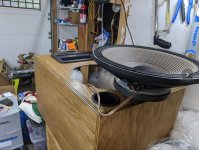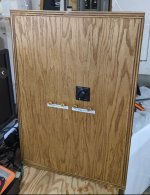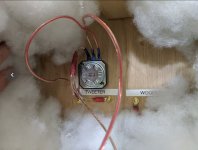Hi all,
I want to simplify my current setup by switching from an active crossover (MiniDSP) to passive one, on my Four Pi speaker clones. My speakers are essentially the same design, with a different port and tuning.
I have access to a calibrated mic, calibrated soundcard and REW, as well as DATS, and so forth.
This is what I am thinking - with measurements taken outside, on the ground, with no close walls / reflections:
Measure the impedance sweep of the tweeter
Measure the impedance sweep of the woofer (mounted normally in the enclosure, so the port is included)
Measure on-axis response of the tweeter at 1 meter / 2.83V RMS
Measure on-axis response of the woofer at 1 meter / 2.83V RMS
Repeat 3 and 4, but off axis (30, 45, 60 degrees)
Use software such as XMachina to import the impedance and frequency responses, and model 2-way crossover from there
If desired, use a DSP to put in the values of the passive crossover, to see what the response looks like
Iterate 6-7 until happy with response/sound
Purchase components
Assemble, test
Joy
Woofer: 15" JBL 2226H, PDF
Tweeter: 1" B&C DE250-8, with the H290C horn/waveguide. Also a 50W LPAD to attenuate the tweeter, which I might, or might not use, with the passive crossover.
Questions:
Is this a sensible approach, or am I missing something?
Should I measure the frequency response (in addition to 2.83V) higher voltage levels to get an understanding of the driver charateristics closer to the actual listening levels?
Many thanks in advance
Bonus, a few pictures (attached)
I want to simplify my current setup by switching from an active crossover (MiniDSP) to passive one, on my Four Pi speaker clones. My speakers are essentially the same design, with a different port and tuning.
I have access to a calibrated mic, calibrated soundcard and REW, as well as DATS, and so forth.
This is what I am thinking - with measurements taken outside, on the ground, with no close walls / reflections:
Measure the impedance sweep of the tweeter
Measure the impedance sweep of the woofer (mounted normally in the enclosure, so the port is included)
Measure on-axis response of the tweeter at 1 meter / 2.83V RMS
Measure on-axis response of the woofer at 1 meter / 2.83V RMS
Repeat 3 and 4, but off axis (30, 45, 60 degrees)
Use software such as XMachina to import the impedance and frequency responses, and model 2-way crossover from there
If desired, use a DSP to put in the values of the passive crossover, to see what the response looks like
Iterate 6-7 until happy with response/sound
Purchase components
Assemble, test
Joy
Woofer: 15" JBL 2226H, PDF
Tweeter: 1" B&C DE250-8, with the H290C horn/waveguide. Also a 50W LPAD to attenuate the tweeter, which I might, or might not use, with the passive crossover.
Questions:
Is this a sensible approach, or am I missing something?
Should I measure the frequency response (in addition to 2.83V) higher voltage levels to get an understanding of the driver charateristics closer to the actual listening levels?
Many thanks in advance
Bonus, a few pictures (attached)
Attachments
Yes it sounds as though you'd get there. I wonder.. do you already know the right responses you need? or are you trying to do the crossover again in the hope of improving?
I do know the target curve I want (essentially a rise from 100Hz and down, otherwise pretty flat towards the top with exception of a -3dB dip ~1-3Khz.
The reason for the project is to make the speakers plug and play and only having to use q si gle amp, versus external DSP and multiple amps.
The reason for the project is to make the speakers plug and play and only having to use q si gle amp, versus external DSP and multiple amps.
Yes, that's reasonable.
What I was thinking is that if you had that curve already because you have been working on the speaker, and you want to translate it then you could measure the response of your line level crossover and use that as a design target.
What I was thinking is that if you had that curve already because you have been working on the speaker, and you want to translate it then you could measure the response of your line level crossover and use that as a design target.




